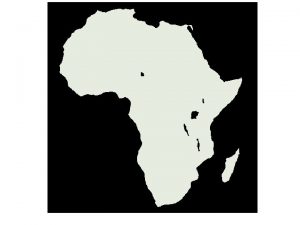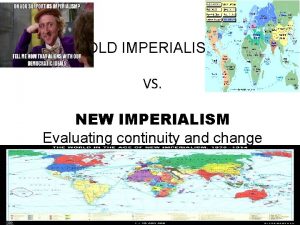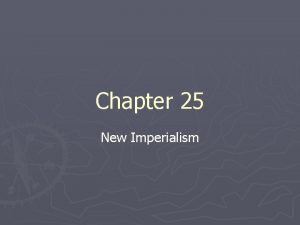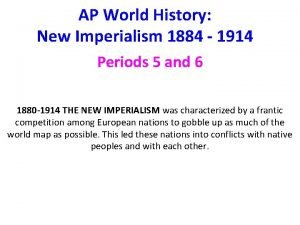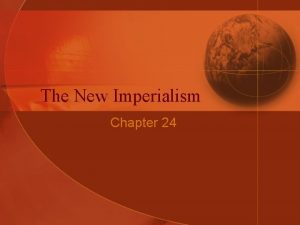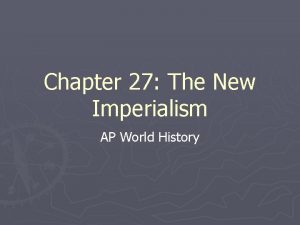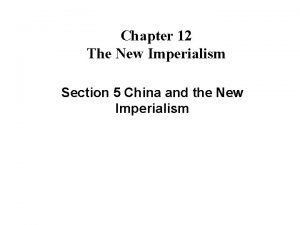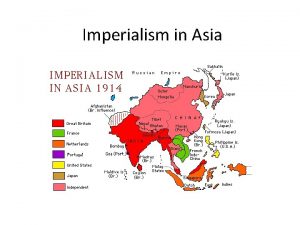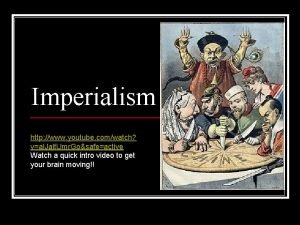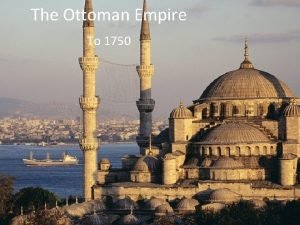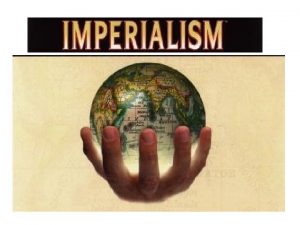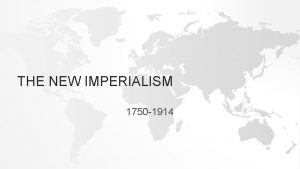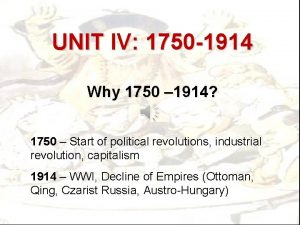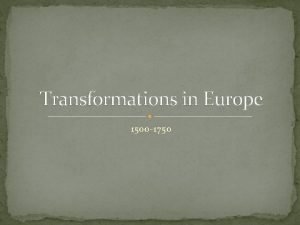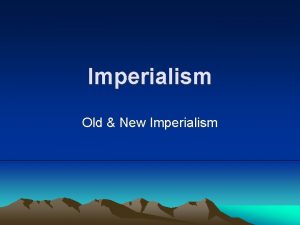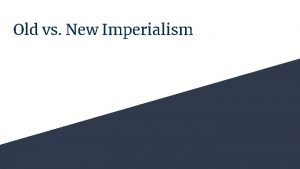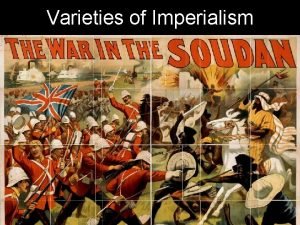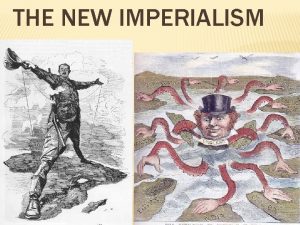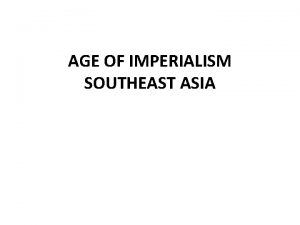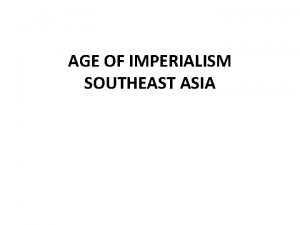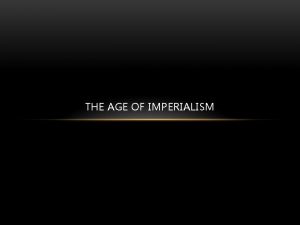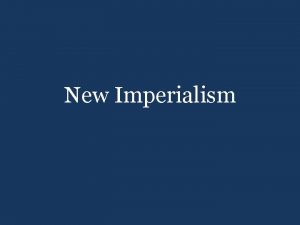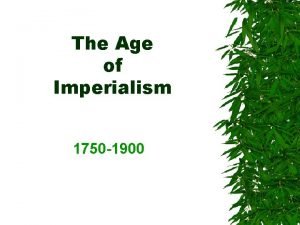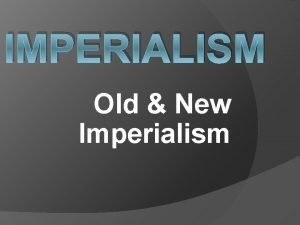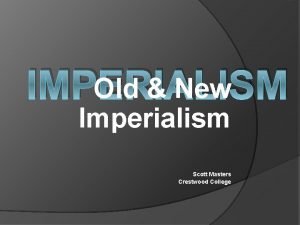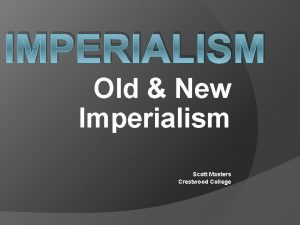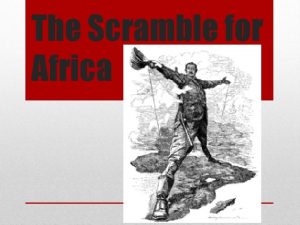Imperialism Old vs New Old Imperialism 1500 1750






















- Slides: 22

Imperialism

Old vs. New • Old Imperialism (1500 -1750) – Trading post empires • England, Portugal, Holland – Colonization of the Americas • New Imperialism (1870 -1914) – Economic/political control (not content with trade) • Africa, Asia, China – Protectorate – places maintained their own governments but were still under the control of an imperial power

Motivation 1. Desire for military strength – On the Importance of Sea Power – Power and Prestige 2. A thirst for new markets – New sources for raw materials (Africa) – New markets for manufactured goods (China) 3. A belief in cultural superiority – Social Darwinism – a natural ‘right’ to dominate weaker people • Europeans ‘most fit’ because of wealth, technology, etc. – “White Man’s Burden” – Missionary work to bring Christianity to ‘uncivilized’ peoples

Technological Advances • Steamships • Suez Canal • Submarine cables – Communication • Quinine – Prevention of Malaria • New weapons – New rifles, machine guns

Imperialism in Africa • Otto von Bismarck (Germany) – 1885 Berlin Conference • Organized division of African continent – Liberia/Ethiopia only remaining independent countries • Consequences – Destroyed native culture – Helped industrialize Africa • Railroads, medicine, telegraph – Increased European rivalries



Imperialism in India • Decline of Mughal Empire British arrival – British focused on trade • British East India Company • Hired Sepoys (Indian soldiers) to protect trade interests – British began reforming Indian government • Weakened regional princes • Private land ownership – Easier to collect taxes • Christian missionary work • Increased agricultural production

The Sepoy Mutiny (1857) • British influence led to oppression – Destroyed cotton textile industries – Oppression leads to discontent • Sepoys rebel – Resented having to fight overseas – Did not want to be converted to Christianity • Most were Hindu or Muslim – Rumor of pig/cow fat being used to grease weapons • Hindus ≠ Cows (Sacred) & Muslims ≠ Pigs (Unclean)

The Mutiny as a Turning Point • Put down by British, leaders killed • Queen Victoria declares freedom of religion, equal protection under the law • A viceroy is appointed to oversee affairs – Replaces East India Company’s rule • Indian National Congress (INC) pushes for reform – Especially to help the poor – Hoped to achieve independence (not until 1947)

Consequences of British Rule • Damaged native culture – Esp. India’s textile industry • Introduced new technologies to India. – Railroad, telegraph, steamships

Imperialism in China • The Opium War (1839 -1842) – British wanted to sell to Chinese – Qing Dynasty restricted trade – British sold opium, refused to ban trade – Chinese burn British warehouses • British defeat Chinese easily – Advanced technology

Results of the Opium War • Treaty of Nanking – Required China to open additional ports of trade – Legalization of Opium trade – British control Hong Kong • China carved into ‘spheres of influence’ – Leads to Taiping Rebellion (Civil War) • 20 -30 million killed

Imperialism in Japan Review of Japanese History: – Emperor existed as a figurehead – Power was with Shogun • (military leader) – Regional lords (Daimyo) controlled day to day – 1600 s – Japan closes borders to outsiders – 1853 – Commodore Matthew Perry arrives • U. S. warships • Demands access for trade

The Japanese Response • Treaty of Kanagawa – Similar to unequal treaties signed by China • Japan feared a similar fate (Opium War) • Daimyo overthrow the Shogun – Leads to civil war in Japan • Meiji Restoration – New government – Restored the Emperor (Mutsuhito)

Impact on Japan • Unlike China, Japan begins widespread industrialization/modernizati on Goals: 1. Protection from western powers 2. Increase own power/prestige Japan will eventually become a colonial power

Comparing Europe and Japan Similarities • Private entrepreneurs • Mechanization – Factory development • Textiles • Women and children participated • Growth of population and technology Differences • Europe began late 1700 s • Japan not until mid 1800 s • Europe motivated by private business interests – (folks wanted to get rich) • Japan motivated by imperialism to protect itself

Imperialism in Latin America (1) • Review: – Independence gained from Spain in early 1800 s – Rich with natural resources – Complicated social/economic hierarchy

Imperialism in Latin America (2) • New: – British/US investors exploited riches • Agricultural and mineral – Supported by Latin American elites • Helped bring about modernization • Increased wealth of the upper class – Imperialists often used military power • Did not attempt to conquer Latin America


Major Imperialism Similarities Positives • Technological advancement – Transportation (RR, roads) – communication (telegraph) • Increase in trade – Raw materials/natural resources • Improved health care and education Negatives • European domination of politics, culture, and economy • Exploitation of people and resources

The Roles of Women (1750 -1914) Similarities • Main role wife/mother • Non-elites worked – Factories, then white collar • Elites did not work outside of the home • Fought/participated in revolutions and independence movements – Fail to gain any major concessions other than some simple education Differences • Suffrage movements in Americas and Europe – No such movements in China, Japan, or India • Chinese elites foot binding • Sati outlawed in India by Mughals and British – Still practiced at times
 Old imperialism motives
Old imperialism motives Old imperialism vs new imperialism chart
Old imperialism vs new imperialism chart New-old approach to creating new ventures
New-old approach to creating new ventures New years old is new again
New years old is new again New imperialism africa
New imperialism africa New imperialism africa
New imperialism africa New imperialism africa
New imperialism africa World history
World history Chapter 24 section 5 china and the new imperialism
Chapter 24 section 5 china and the new imperialism New imperialism definition ap world history
New imperialism definition ap world history Chapter 12 section 5 china and the new imperialism
Chapter 12 section 5 china and the new imperialism Imperialism
Imperialism Natural resources imperialism
Natural resources imperialism Asia imperialism
Asia imperialism Causes of new imperialism
Causes of new imperialism Lesson 1: the new imperialism
Lesson 1: the new imperialism Mughal empire 1450 to 1750
Mughal empire 1450 to 1750 1750-1900 portfolio map
1750-1900 portfolio map Ottoman empire 1815
Ottoman empire 1815 What period lasted from 1750-1825?
What period lasted from 1750-1825? It is an era from 1750-1820
It is an era from 1750-1820 Baroque period
Baroque period Fur trade ap world history
Fur trade ap world history
